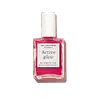What's inside
What's inside
 Key Ingredients
Key Ingredients

 Benefits
Benefits

 Concerns
Concerns

 Ingredients Side-by-side
Ingredients Side-by-side

Ethyl Acetate
PerfumingButyl Acetate
MaskingNitrocellulose
Adipic Acid/Neopentyl Glycol/Trimellitic Anhydride Copolymer
Acetyl Tributyl Citrate
MaskingAlcohol
AntimicrobialGlycolic Acid
BufferingCaprylic/Capric Triglyceride
MaskingEtocrylene
UV AbsorberPrunus Amygdalus Dulcis Oil
Skin ConditioningGlycerin
HumectantWater
Skin ConditioningCI 15850
Cosmetic ColorantIsopropyl Alcohol
SolventHibiscus Sabdariffa Flower Extract
Skin ConditioningLactobacillus Ferment
Skin ConditioningCI 60725
Cosmetic ColorantVitis Vinifera Fruit Extract
Skin ConditioningVaccinium Myrtillus Fruit Extract
Skin ConditioningRubus Idaeus Leaf Extract
Skin ConditioningTocopherol
AntioxidantEthyl Acetate, Butyl Acetate, Nitrocellulose, Adipic Acid/Neopentyl Glycol/Trimellitic Anhydride Copolymer, Acetyl Tributyl Citrate, Alcohol, Glycolic Acid, Caprylic/Capric Triglyceride, Etocrylene, Prunus Amygdalus Dulcis Oil, Glycerin, Water, CI 15850, Isopropyl Alcohol, Hibiscus Sabdariffa Flower Extract, Lactobacillus Ferment, CI 60725, Vitis Vinifera Fruit Extract, Vaccinium Myrtillus Fruit Extract, Rubus Idaeus Leaf Extract, Tocopherol
Ethyl Acetate
PerfumingButyl Acetate
MaskingNitrocellulose
Triethyl Citrate
MaskingAlcohol
AntimicrobialAdipic Acid/Neopentyl Glycol/Trimellitic Anhydride Copolymer
Prunus Armeniaca Kernel Oil
MaskingAscorbyl Palmitate
AntioxidantChenopodium Quinoa Seed Extract
Skin ConditioningHydrolyzed Cicer Seed Extract
Skin ProtectingLens Esculenta Seed Extract
Skin ProtectingWater
Skin ConditioningGlycerin
HumectantAmethyst Powder
AbrasiveLactic Acid
BufferingPotassium Sorbate
PreservativeSodium Benzoate
MaskingCI 60725
Cosmetic ColorantXanthan Gum
EmulsifyingEthyl Acetate, Butyl Acetate, Nitrocellulose, Triethyl Citrate, Alcohol, Adipic Acid/Neopentyl Glycol/Trimellitic Anhydride Copolymer, Prunus Armeniaca Kernel Oil, Ascorbyl Palmitate, Chenopodium Quinoa Seed Extract, Hydrolyzed Cicer Seed Extract, Lens Esculenta Seed Extract, Water, Glycerin, Amethyst Powder, Lactic Acid, Potassium Sorbate, Sodium Benzoate, CI 60725, Xanthan Gum
Ingredients Explained
These ingredients are found in both products.
Ingredients higher up in an ingredient list are typically present in a larger amount.
We don't have a description for Adipic Acid/Neopentyl Glycol/Trimellitic Anhydride Copolymer yet.
Alcohol comes in many different forms. Different types of alcohol will have different effects on skin. This ingredient is usually an astringent alcohol.
These alcohols are drying on the skin. They may strip away your skin's natural oils and even damage your skin barrier. Astringent alcohols may also irritate skin.
Other types of astringent alcohols include:
According to the National Rosacea Society based in the US, you should be mindful of products with these alcohols in the top half of ingredients.
Any type of sanitizing product will have high amounts of alcohol to help kill bacteria and viruses.
Fatty alcohols come from plant oils such as coconut oil. These can help hydrate the skin and are non-irritating. Some fatty alcohols include cetyl and stearyl alcohol.
Learn more about AlcoholWe don't have a description for Butyl Acetate yet.
This synthetic colorant is used to add a violet color to products. It is water-soluble.
Ethyl Acetate is a fragrance.
Glycerin is already naturally found in your skin. It helps moisturize and protect your skin.
A study from 2016 found glycerin to be more effective as a humectant than AHAs and hyaluronic acid.
As a humectant, it helps the skin stay hydrated by pulling moisture to your skin. The low molecular weight of glycerin allows it to pull moisture into the deeper layers of your skin.
Hydrated skin improves your skin barrier; Your skin barrier helps protect against irritants and bacteria.
Glycerin has also been found to have antimicrobial and antiviral properties. Due to these properties, glycerin is often used in wound and burn treatments.
In cosmetics, glycerin is usually derived from plants such as soybean or palm. However, it can also be sourced from animals, such as tallow or animal fat.
This ingredient is organic, colorless, odorless, and non-toxic.
Glycerin is the name for this ingredient in American English. British English uses Glycerol/Glycerine.
Learn more about GlycerinWe don't have a description for Nitrocellulose yet.
Water. It's the most common cosmetic ingredient of all. You'll usually see it at the top of ingredient lists, meaning that it makes up the largest part of the product.
So why is it so popular? Water most often acts as a solvent - this means that it helps dissolve other ingredients into the formulation.
You'll also recognize water as that liquid we all need to stay alive. If you see this, drink a glass of water. Stay hydrated!
Learn more about Water